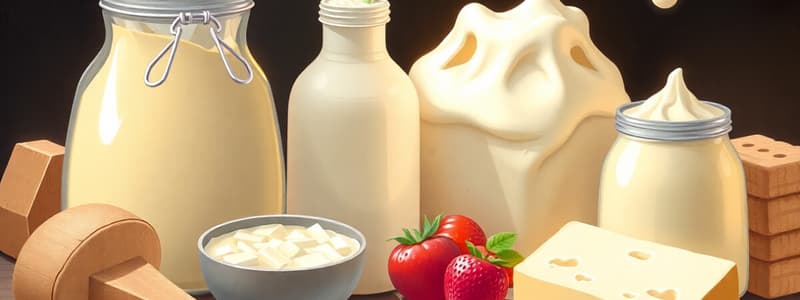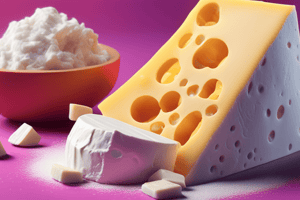Podcast
Questions and Answers
¿Qué tipo de leche se declara como exclusivamente leche de vaca?
¿Qué tipo de leche se declara como exclusivamente leche de vaca?
- Leche cruda
- Leche entera
- Leche sin especificar especie (correct)
- Leche higienizada
La leche cruda ha sido sometida a tratamientos térmicos.
La leche cruda ha sido sometida a tratamientos térmicos.
False (B)
¿Cuál es uno de los principales riesgos que representan los microorganismos en productos lácteos?
¿Cuál es uno de los principales riesgos que representan los microorganismos en productos lácteos?
Alteración de productos o producción de toxinas.
La leche higienizada ha sido sometida a procesos de __________.
La leche higienizada ha sido sometida a procesos de __________.
Relaciona los métodos de conservación con sus descripciones:
Relaciona los métodos de conservación con sus descripciones:
¿Cuál de los siguientes factores antimicrobianos presente en la leche es responsable de romper enlaces peptidoglicano?
¿Cuál de los siguientes factores antimicrobianos presente en la leche es responsable de romper enlaces peptidoglicano?
La lactoperoxidasa tiene un efecto antimicrobiano sobre mohos y levaduras.
La lactoperoxidasa tiene un efecto antimicrobiano sobre mohos y levaduras.
¿Qué proteína presente en la leche se encarga de fijar hierro?
¿Qué proteína presente en la leche se encarga de fijar hierro?
La _________ se inactiva mediante aglutinación.
La _________ se inactiva mediante aglutinación.
Relaciona los factores antimicrobianos con su efecto:
Relaciona los factores antimicrobianos con su efecto:
¿Cuál de las siguientes vitaminas es transportada por las proteínas lácteas?
¿Cuál de las siguientes vitaminas es transportada por las proteínas lácteas?
La microbiota inicial en la leche cruda es siempre inferior a 103 UFC/mL.
La microbiota inicial en la leche cruda es siempre inferior a 103 UFC/mL.
¿Cuál es el pH de la leche en condiciones óptimas?
¿Cuál es el pH de la leche en condiciones óptimas?
La adición de bicarbonato de sodio se utiliza para aumentar la acidez de la leche adulterada.
La adición de bicarbonato de sodio se utiliza para aumentar la acidez de la leche adulterada.
¿Qué tipo de microorganismos puede ser detectado con la reducción del azul de metileno?
¿Qué tipo de microorganismos puede ser detectado con la reducción del azul de metileno?
La leche adulterada sufre un cambio __________ en su composición.
La leche adulterada sufre un cambio __________ en su composición.
Relaciona cada proceso con su efecto en la leche:
Relaciona cada proceso con su efecto en la leche:
¿Cuál de los siguientes métodos se utiliza para determinar residuos de antibióticos en la leche cruda?
¿Cuál de los siguientes métodos se utiliza para determinar residuos de antibióticos en la leche cruda?
La separación y clarificación de la leche no elimina microorganismos.
La separación y clarificación de la leche no elimina microorganismos.
¿Qué sucede a la leche cuando tiene un alto contenido de bacterias y se aplica el método de reducción del azul de metileno?
¿Qué sucede a la leche cuando tiene un alto contenido de bacterias y se aplica el método de reducción del azul de metileno?
La Aw de la leche en condiciones óptimas es de __________.
La Aw de la leche en condiciones óptimas es de __________.
¿Cuál es el objetivo principal de la pasteurización y el método HTST?
¿Cuál es el objetivo principal de la pasteurización y el método HTST?
El método UHT no requiere refrigeración posterior.
El método UHT no requiere refrigeración posterior.
¿Qué tipo de microorganismos sobreviven a los tratamientos de pasteurización y HTST?
¿Qué tipo de microorganismos sobreviven a los tratamientos de pasteurización y HTST?
La pasteurización requiere enfriamiento inmediato a ______ °C hasta alcanzar los 4°C.
La pasteurización requiere enfriamiento inmediato a ______ °C hasta alcanzar los 4°C.
Asocia los siguientes términos con su descripción:
Asocia los siguientes términos con su descripción:
¿Cuál es una desventaja del tratamiento térmico PCC?
¿Cuál es una desventaja del tratamiento térmico PCC?
La pasteurización y el método UHT eliminan las células vegetativas.
La pasteurización y el método UHT eliminan las células vegetativas.
¿Qué se entiende por 'esterilidad comercial' en el contexto de procesos térmicos?
¿Qué se entiende por 'esterilidad comercial' en el contexto de procesos térmicos?
El parámetro de calidad de coliformes termotolerantes debe ser menor a ______ UFC/mL.
El parámetro de calidad de coliformes termotolerantes debe ser menor a ______ UFC/mL.
Flashcards
Raw milk
Raw milk
Milk that has not been heat-treated (e.g., pasteurized).
Pasteurization
Pasteurization
A heat treatment process used to kill harmful bacteria in milk.
Milk microbes
Milk microbes
Microorganisms, both beneficial and harmful, that exist in milk.
Dairy products
Dairy products
Signup and view all the flashcards
Milk processing methods
Milk processing methods
Signup and view all the flashcards
Lactoperoxidase system
Lactoperoxidase system
Signup and view all the flashcards
Lactoferrin
Lactoferrin
Signup and view all the flashcards
Lysozyme
Lysozyme
Signup and view all the flashcards
Antimicrobial factors in milk
Antimicrobial factors in milk
Signup and view all the flashcards
Initial microbiota of raw milk
Initial microbiota of raw milk
Signup and view all the flashcards
Milk's biofilms
Milk's biofilms
Signup and view all the flashcards
Milk composition
Milk composition
Signup and view all the flashcards
Leche adulterada
Leche adulterada
Signup and view all the flashcards
Temperatura óptima (bacteria)
Temperatura óptima (bacteria)
Signup and view all the flashcards
pH óptimo (bacteria)
pH óptimo (bacteria)
Signup and view all the flashcards
Aw óptimo (bacteria)
Aw óptimo (bacteria)
Signup and view all the flashcards
Reducción del Azul de Metileno
Reducción del Azul de Metileno
Signup and view all the flashcards
Clarificación de la leche
Clarificación de la leche
Signup and view all the flashcards
Homogenización
Homogenización
Signup and view all the flashcards
RTCR 2007
RTCR 2007
Signup and view all the flashcards
Células Somáticas
Células Somáticas
Signup and view all the flashcards
Pasteurization
Pasteurization
Signup and view all the flashcards
HTST
HTST
Signup and view all the flashcards
UHT
UHT
Signup and view all the flashcards
F0
F0
Signup and view all the flashcards
Spoilage Organisms (bacteria)
Spoilage Organisms (bacteria)
Signup and view all the flashcards
Pathogens
Pathogens
Signup and view all the flashcards
Post-pasteurization contamination
Post-pasteurization contamination
Signup and view all the flashcards
Temperature requirements for Cooling
Temperature requirements for Cooling
Signup and view all the flashcards
Coliforms and RTA
Coliforms and RTA
Signup and view all the flashcards




